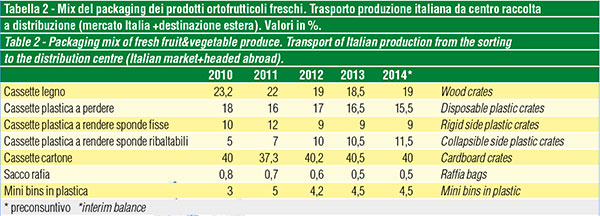Fruit&Vegetables and packaging
The “numbers” of the Italian fresh produce market and focus on the relative type of packaging, from the field to the shelf.
Italy is the largest European producer of fruit&vegetables (24% of the total) and, with a share of 2%, stands in sixth place in the world rating, after giants the calibre of China (40% of total fresh produce), India (10%), USA (5%) Brazil and Turkey (both at 3%)

Production, consumption and salespoints
According to the interim balance for 2014, Italian production should have terminated the year totalling 34,100 t/000, slightly down on 2013. It is rated that around 35% is accounted for by the production of fresh produce for direct consumption (domestic market + exporters) with around 12,100 t/000: +7% on 2013 thanks to the growth of exports, that show a growthtrend of around 3%.
Italy certainly ranks among the largest world exporters of fresh produce: in the decade 2004/2013 it in fact gained sixth place in the world exporter rating, in particular for fruit. Imports have dropped considerably. Domestic demand in 2014 showed a drop of 2-3% in volume and 3.3% in value, involving both household consumption and horeca.
On the basis of the figures expressed in the 2014 edition of the Coop Consumption and Distribution report, in the three years 2011-2013 Italian fruit and vegetable consumption dropped by 12%, with a shift to less expensive merchandise categories. In terms of sources of purchase, according to studies under Macfruit, the discount share continues to grow both in volume and in value, local markets are holding their own while hyper- and supermarkets and grocers’ show a drop. The area of convenience produce (washed, cut, packed fresh produce ready to be served and dressed), even if the growthtrends have slowed compared to the recent past: + 1-1.5% annual average compared to the around 3% annual average of recent years.

Types of packaging
The handling of fresh produce is done in three phases corresponding to three different packaging solutions:
- transport from the field to the sorting centres (consortiums, storage depots etc.);
- transport from the sorting to the distribution centres (local markets, largescale retail etc.);
- consumer sales.

The transport from the field to the sorting centres occurs using returnable packaging. Plastic bins with fixed or collapsible sides are showing progressive growth: currently around 78% of produce is handled with this system (at the beginning of 2000 the share was 65%).
Wood bins continue to suffer the competition of the plastic equivalent (with a share no higher than 17%). Both types are returnable. The remaining 5% is made up of crates, both in plastic and in wood, that have a high rotation: they are used for the most delicate produce that doesn’t travel long distances.
Regarding transportation from the sorting to the distribution centers the packaging solutions are more varied and the growthtrends are dynamic. For many years wood crates were the main packaging in this area, also with a significant presence of returnables, that have now disappeared from the market.
Legislative health and sanitary rulings that only enabled their reuse after thorough reclamation triggered their progressive drop.
In 2013 the share of wood crates (all disposable) was 19%, marking a recovery compared to the drop seen in the last years (18.5% in 2012), thanks aboveall to exports.
Corrugated cardboard crates currently have a stable share of 40%, with higher amounts for produce for export. Their strongpoint is their potential for personalization with ad hoc graphics.
Direct competitor of the cardboard crate is the plastic crate. Overall (produce for the Italian market plus exports), plastic crates have a share of 36%, of which: 15.5% disposable crates whose share is dropping progressively, 9% fixed side returnable crates and 11.5% returnable crates with collapsible sides (used mainly for products destined for the Italian market), both showing growth.
In this field, the great new feature over the last five years has been the progressive encroachment of the “returnable” plastic crates, that put in 16-18 round trips per year, the objective is to reach 20 round trips/year. Transport from the sorting to the distribution centers also comes about with the use of nets for potatoes and onions (0.5%) and returnable plastic minibins used with largescale retail (4.5%) and mainly used for melons, potatoes, oranges, apples, lemons etc.

Also in terms of fresh produce for direct consumption, the mix of packaging types is very varied and extremely dynamic. Currently for the sale for direct consumption of fruit&vegetable produce plastic packaging prevails. Plastic baskets and trays, in many cases with stretchfilm, account for a stable share of 28%. The plastic bag, understood as primary packaging in contact with the product, has shown a continuous growth since 2000 (currently it is at 31.5%), due to purchases made at largescale retail centres, where it is used to weigh and price loose produce.
The emerging packaging is the tray with lid in plastic polylaminate, where the product is preserved in protective atmosphere, that has reached a share of 10.5% (in 2007 it was 3.8%!). This solution concerns convenience produce, that shows interesting growth potential. Other types of packaging used for sale to the consumer are the cardboard basket, generally used for some biological produce, and the raffia net for potatoes, onions, garlic lemons etc. It is considered that the virgin plastic used for bags and trays will be progressively replaced by biopolymers. This trend though should not affect that packaging of convenience produce, for which trays and bags in flexible converter polylaminate derived from virgin plastics are used.
Plinio Iascone
Istituto Italiano Imballaggio

















